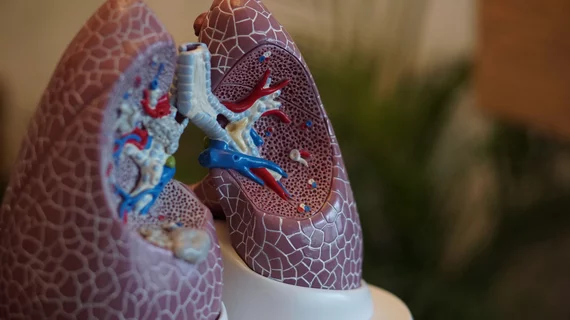Ultrashort echo time MRI ‘valuable’ for assessing pulmonary diseases in COVID-19 patients
Ultrashort echo time MRI is useful for assessing COVID-19 patients with various pulmonary diseases, according to a new study published Wednesday.
A crew of Chinese doctors found that UTE-MR imaging was on-par with CT scan quality at detecting some of the most common findings associated with the disease, including lesions and ground-glass opacities, in a group of 23 patients. And while there’s been ongoing debate about whether CT should be deployed as a first-line screening option for the virus, with many industry groups in the U.S. recommending against it, other countries that have been hit hard, such as Italy and China, have found success using the modality.
Lead author Shuyi Yang, PhD, MD, with Shanghai Public Health Clinical Center, and colleagues also reported no significant differences in image quality between the two modalities June 3 in the Journal of MRI.
As cases of COVID-19 continue to grow in many regions of the world, the researchers believe UTE-MRI may be able to help.
“With the continuous and rapid global spread of COVID‐19, imaging examination has been widely accepted as a useful tool for aiding the control of COVID‐19 patients,” the authors wrote. “This study suggests that UTE‐MRI may act as a potential alternative to CT for noninvasively evaluating COVID‐19.”
For their prospective study, Yang et al. included 23 patients with lab-confirmed coronavirus who underwent both a CT exam and MR imaging using respiratory-gate three-dimensional radial UTE pulse sequence.
Between both modalities, patient and lesion-based interobserver agreement for pinpointing signs of COVID-19 were considered “excellent.”
Both methods also took a similar approach to assessing virus-associated findings, such as including affected lobes, total severity score, ground-glass opacities, consolidation, GGO with consolidation, the number of crazy paving patterns, and linear opacities. Yang et al. described this intermethod agreement as “substantial or excellent.”
“Due to the high concordance with CT for visualizing the representative pulmonary findings and an image quality similar to CT, UTE‐MRI is considered valuable for evaluating the radiological findings of patients with various pulmonary parenchyma diseases,” the authors concluded.

